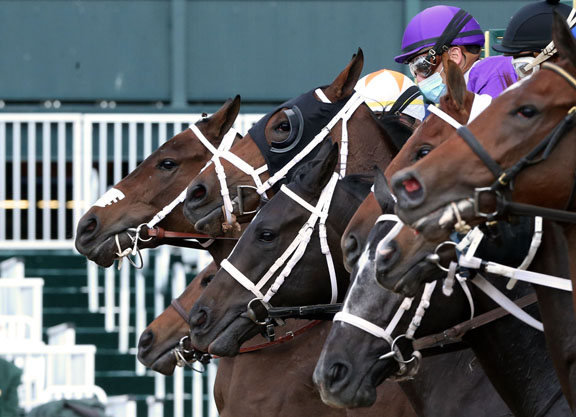by Thoroughbred Idea Foundation
The creation of the Horseracing Integrity and Safety Authority (HISA) is the most significant development in American racing at the federal level since the passage of the Interstate Horseracing Act in 1978.
Questions now being rightly considered include how much HISA will cost and where will its funding originate from. Below, we offer some perspective on the costs. But as the greater industry determines where the funding will come from over time, racing should proactively adopt policies which seek to grow the wagering business.
The industry already has a plethora of obligations–aftercare, backstretch programs, integrity matters, jockey health and equine research, not to mention purses, the main driver for investment from owners. HISA adds to these. The best way for horse racing to afford all of its obligations is to grow the business.
Racing's wagering business needs to evolve–appropriate pricing of bets, improving access and reducing costs to accurate data, complementing pari-mutuel betting with fixed odds options, modernizing existing bet processing and infrastructure, all while increasing transparency to the public in many areas. Increasing costs to our already fragile wagering markets, or to a declining base of horse owners, without these needed improvements is a recipe for disaster.
Any step where costs to betting are increased to help pay for HISA programs will hurt the greater racing business.
Projecting Costs
There is every reason to expect that a new level of federal bureaucracy functioning on top of individual state commissions will be expensive.
As it relates to testing, these expenses are fairly clear. For example, if the per-race spending on testing alone from the more than 5,000 races across all breeds overseen by the California Horse Racing Board were extrapolated across the entirety of U.S. Thoroughbred racing, nationwide testing alone would run approximately $20 million annually at current standards.
This is a cost already borne by individual commissions.
Factoring in improvements and upgraded requirements, it should be understood that the $20 million–just for testing–merely represents a starting point.
Administratively, what it will cost to start a federal authority from scratch is more challenging to envision. The HISA creates a layer of federal bureaucracy where one never previously existed. This isn't necessarily good or bad, it is a reality in development with little insight on costs to this point.
HISA requires the registration of all “covered persons”–an umbrella term which, according to the language of the bill, includes “all trainers, owners, breeders, jockeys, racetracks, veterinarians, persons (legal and natural) licensed by a State racing commission and the agents, assigns, and employees of such persons and other horse support personnel who are engaged in the care, training, or racing of covered horses [basically, all active Thoroughbreds].”
Most are already licensed by existing commissions, but some are not. Will that information be shared or require completely new registrations? The exact administrative requirements are (understandably) unknown to this point, but all of this will come with costs.
The United States Anti-Doping Agency (USADA), which will assist in the development of HISA, serves as a potential reference point to understand the possible administrative expenses.
According to its annual report, USADA conducted more than 14,000 tests in 2019 across various groups which include America's Olympic and Paralympic athletes, services to the UFC or contracted services for other events, such as the Boston and New York City Marathons. Off a base of just 30,000 Thoroughbred races, down from 36,000 run in 2019, it is reasonable to expect the number of annual tests in U.S. Thoroughbred racing would be no less than five times larger than those conducted by USADA, and very likely more.
USADA's testing costs in 2019 ran more than $13.5 million, but non-testing expenses, which includes results management, science, research and development and drug reference, education and awareness, as well as general and administrative expenses totaled an additional $9.3 million.
It would be reasonable to estimate that HISA's costs would be similar, if not more, given a substantially increased number of tests, across a far larger base of competitors and events (races) requiring tests.
Whatever the exact costs, it will be more than in pre-HISA times.
Grow the Business
The best chance racing has of covering HISA costs is if racing finds a way to actually grow the business, turning around two decades of decline.
Grow the business. Grow the business. Grow the business.
State commissions are, for the most part, funded through fees assessed to, or withheld from, the sport's participants. Receiving a portion of the hold from wagering takeout is one source of funding, licensing fees and starter fees are another. Some receive funding through a share of alternative gaming revenue too.
If wagering on racing continues to decline, recalling that it has dropped roughly 50% adjusted for inflation over nearly the last two decades, the ability to pay for HISA and plenty of other programs required of the industry–aftercare initiatives, jockey health, equine research, among others–would grow increasingly difficult. Takeout hikes would be a completely counterproductive measure to pay for HISA as betting churn would decline.
The path to a brighter future, where the industry's liabilities can be covered, is wagering growth.
More wagering on racing yields a more sustainable business for all stakeholders. But yet, many of the decisions made by racing operators over the last two decades have been in opposition to growing wagering on racing. This has to change.
Whether it is the continuation of churn-killing jackpot bets, high takeout rates, an aversion from many to exploring fixed-odds options, or continuing to operate antiquated pari-mutuel bet-processing systems without modernization–these and other actions have greatly limited racing's growth, all as the sport's liabilities increase and its social license to operate becomes tougher to retain.
As racing and humanity emerge from a troubling calendar year, make no mistake that 2020 was a year of tremendous growth in legal sports betting. Those states doing the best with sports betting are those which have embraced online betting and competitive markets. While the overall environment for betting has never been stronger, racing's wagering product remains stagnant.
If racing wants to succeed, and cover its growing liabilities which now include HISA, it must undertake measures to radically improve–and grow–the wagering business.
Not a subscriber? Click here to sign up for the daily PDF or alerts.






